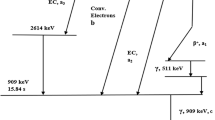Abstract
Accurate attenuation correction is a prerequisite for the determination of exact local radioactivity concentrations in positron emission tomography. Attenuation correction factors range from 4–5 in brain studies to 50–100 in whole body measurements. This report gives an overview of the different methods of determining the attenuation correction factors by transmission measurements using an external positron emitting source. The long-lived generator nuclide68Ge/68Ga is commonly used for this purpose. The additional patient dose from the transmission source is usually a small fraction of the dose due to the subsequent emission measurement. Ring-shaped transmission sources as well as rotating point or line sources are employed in modern positron tomographs. By masking a rotating line or point source, random and scattered events in the transmission scans can be effectively suppressed. The problems of measured attenuation correction are discussed: transmission/emission mismatch, random and scattered event contamination, counting statistics, transmission/emission scatter compensation, transmission scan after administration of activity to the patient. By using a double masking technique simultaneous emission and transmission scans become feasible.
Similar content being viewed by others
References
Carroll LR, Kretz P, Orcutt G (1983) The orbiting rod source: Improving performance in PET transmission correction scans. In: Esser PD (ed) Emission computed tomography: Current trends. Society of Nuclear Medicine, New York, pp 235–247
Carson RE, Daube-Witherspoon ME, Green MV (1988) A method for postinjection PET transmission measurements with a rotating source. J Nucl Med 29:1558–1567
Chen C-T, Beck RN, Cooper MD (1987) Noise and inaccuracy introduced by attenuation correction in positron emission tomography. Med Phys 14:470 (A)
Dahlbom M, Hoffman EJ (1987) Problems in signal-to-noise ratio for attenuation correction in high resolution PET. IEEE Trans Nucl Sci 34:288–293
Derenzo SE, Budinger TF, Huesman RH, Cahoon JL, Vuletich T (1981) Imaging properties of a positron tomograph with 280 BGO crystals. IEEE Trans Nucl Sci 28:81–89
Derenzo SE, Huesman RH, Cahoon JL, Geyer AB, Moses WW, Uber DC, Vuletich T, Budinger TF (1988) A positron tomograph with 600 BGO crystals and 2.6 mm resolution. IEEE Trans Nucl Sci 35:659–664
Huang S-C, Hoffman EJ, Phelps ME, Kuhl DE (1979) Quantitation in positron emission computed tomography: 2. Effects of inaccurate attenuation correction. J Comput Assist Tomogr 3:804–814
Huesman RH, Derenzo SE, Cahoon JL, Geyer AB, Moses WW, Uber DC, Vuletich T, Budinger TF (1988) Orbiting transmission source for positron tomography. IEEE Trans Nucl Sci 35:735–739
Iida H, Miura S, Kanno I, Murakami M, Takahashi K, Uemura K, Hirose Y, Amano M, Yamamoto S, Tanaka K (1989) Design and evaluation of HEADTOME-IV. A whole-body positron emission tomograph. IEEE Trans Nucl Sci 36:1006–1010
Kanno I, Miura S, Yamamoto S, Iida H, Murakami M, Takahashi K, Uemura K (1985) Design and evaluation of a positron emission tomograph: HEADTOME III. J Comput Assist Tomogr 9:931–939
Kübler WK, Ostertag H, Hoverath H, Doll J, Ziegler S, Lorenz WJ (1988) Scatter suppression by using a rotating pin source in PET transmission measurements. IEEE Trans Nucl Sci 35:749–752
Lewellen TK, Bice AN, Harrison RL, Pencke MD, Link JM (1988) Performance measurements of the SP3000/UW time-of-flight positron emission tomograph. IEEE Trans Nucl Sci 35:665–669
Palmer MR, Rogers JG, Bergström M, Beddoes MP, Pate BD (1986) Transmission profile filtering for positron emission tomography. IEEE Trans Nucl Sci 33:478–481
Senda M, Tamaki N, Yonekura Y, Tanada S, Murata K, Hayashi N, Fujita T, Saji H, Konishi J, Torizuka K, Ishimatsu K, Takami K, Tanaka E (1985) Performance characteristics of Positologica III: A whole-body positron emission tomograph. J Comput Assist Tomogr 9:940–946
Spinks TJ, Jones T, Gilardi MC, Heather JD (1988) Physical performance of the latest generation of commercial positron scanner. IEEE Trans Nucl Sci 35:721–725
Ter-Pogossian MM, Ficke DC, Yamamoto M, Hood JT Sr (1982) Super PETTI: A positron emission tomograph utilizing photon time-of-flight information. IEEE Trans Med Imaging 1:179–187
Thompson CJ, Dagher A, Lunney DN, Strother SC, Evans AC (1986) A technique to reject scattered radiation in PET transmission scans. In: Nalcioglu O, Cho ZH, Budinger TF (eds) International workshop on physics and engineering of computerized multidimensional imaging and processing. Proc SPIE 671:244–253
Thompson CJ, Ranger NT, Evans AC (1989) Simultaneous transmission and emission scans in positron emssion tomography. IEEE Trans Nucl Sci 36:1011–1016
Author information
Authors and Affiliations
Rights and permissions
About this article
Cite this article
Ostertag, H., Kübler, W.K., Doll, J. et al. Measured attenuation correction methods. Eur J Nucl Med 15, 722–726 (1989). https://doi.org/10.1007/BF00631764
Issue Date:
DOI: https://doi.org/10.1007/BF00631764




